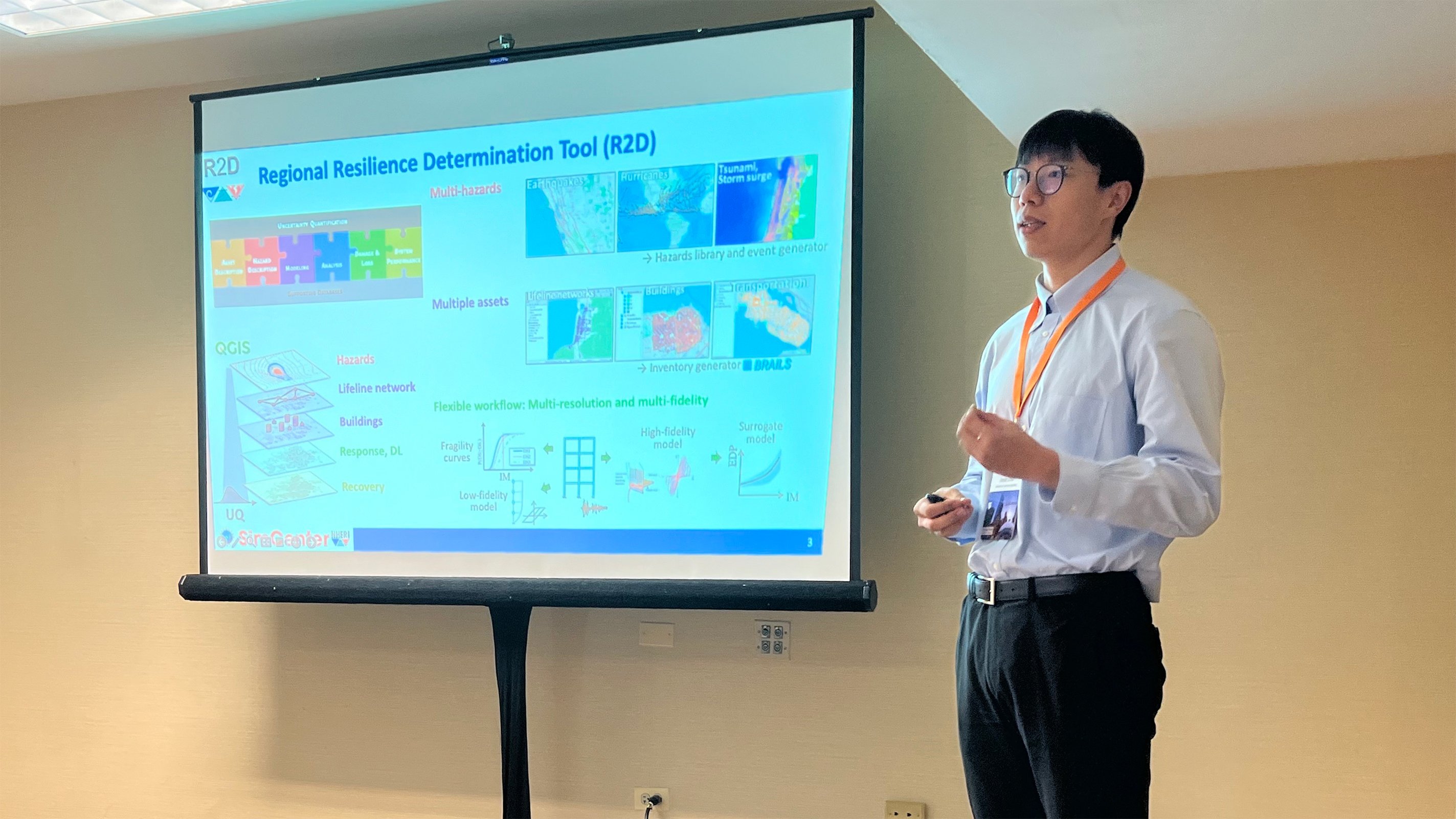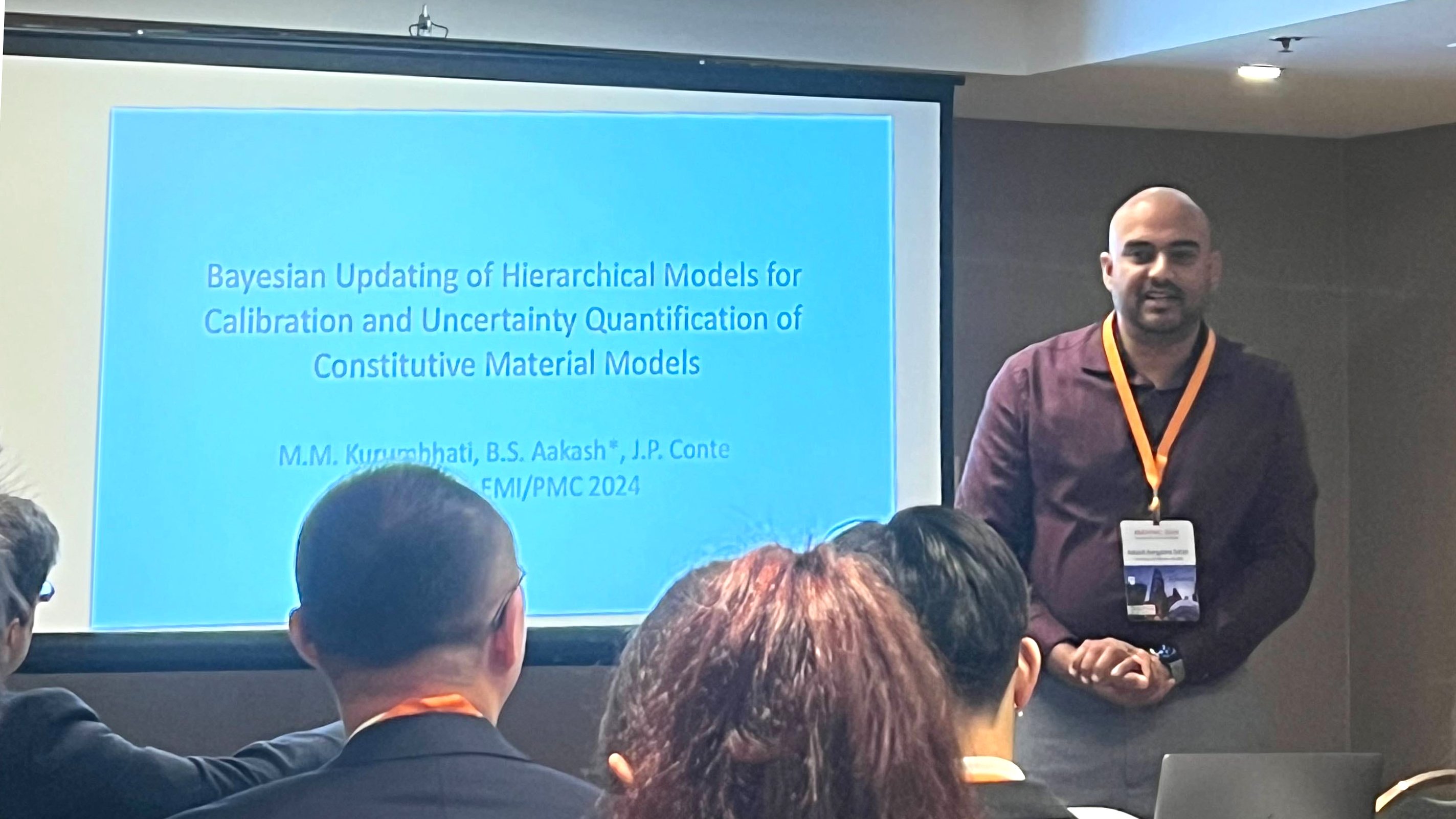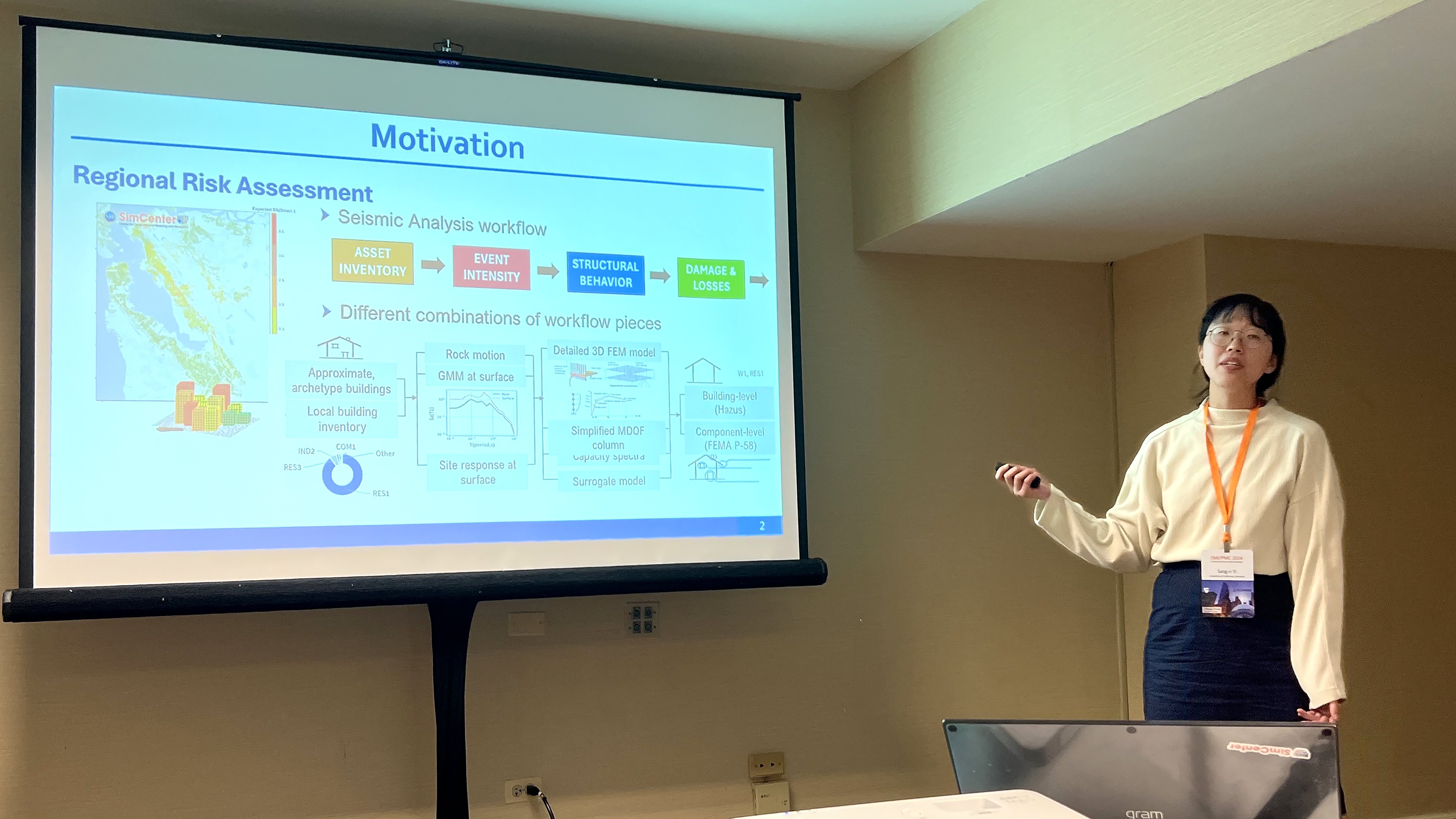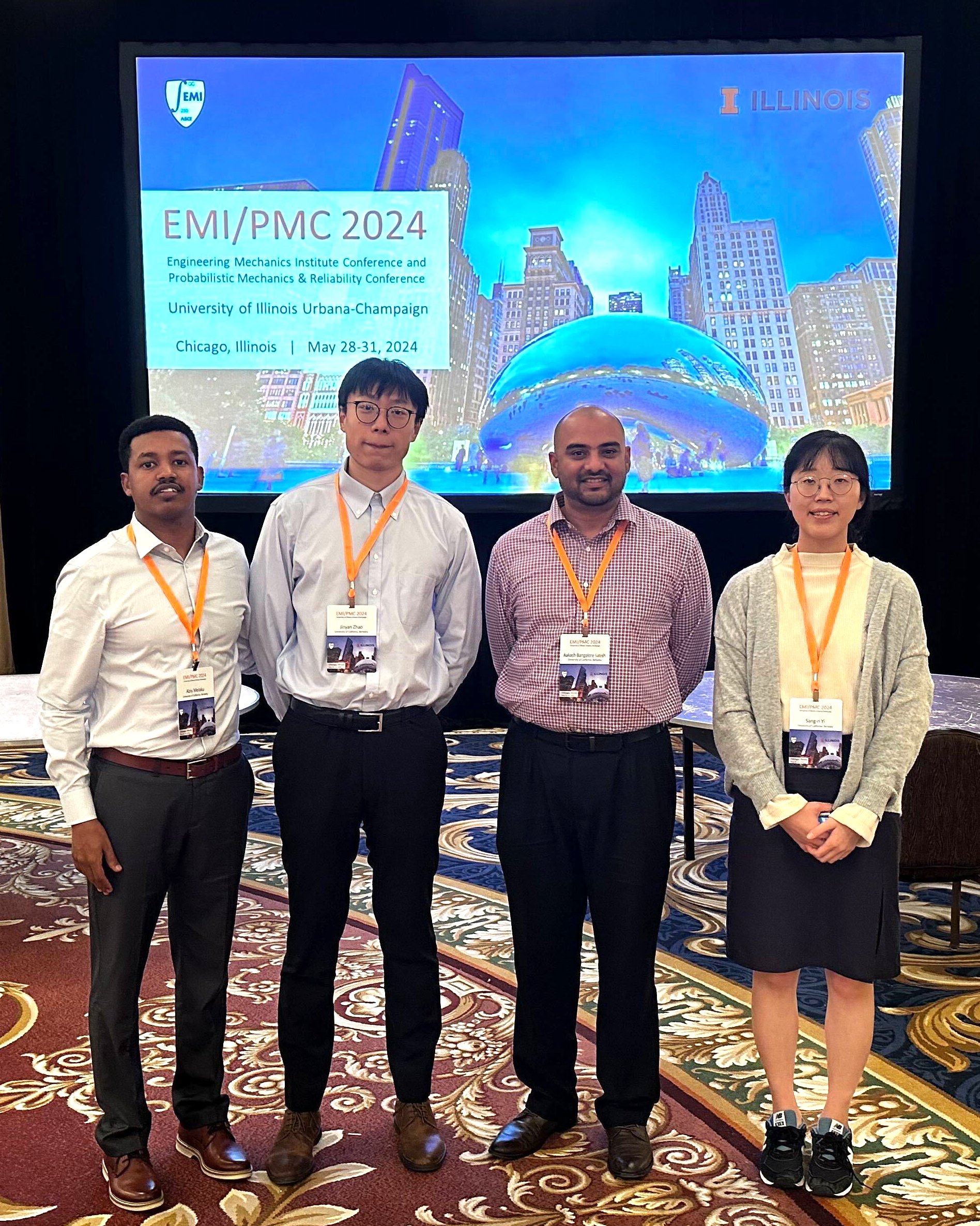SimCenter researchers and software developers actively engaged the engineering mechanics community at the ASCE Engineering Mechanics Institute Conference and Probabilistic Mechanics & Reliability Conference (EMI/PMC 2024), which was held in Chicago, Illinois, on May 28-31, 2024. SimCenter postdoctoral scholars and software developers Sang-ri Yi, Aakash Bangalore Satish, Jinyan Zhao, and Abiy Melaku provided presentations as noted with *. Participating SimCenter personnel including domain experts are noted in italics.
Objective Resilience Committee Meeting:
- “SimCenter tools to support infrastructure resilience assessment.” Jinyan Zhao*. This presentation provided examples 1) using SimCenter PBE and the recovery simulation module REDi to support the resilience assessment of individual structures, and 2) using SimCenter R2D and the recovery simulation model Pyrecodes to support resilience assessment of communities with interdependent infrastructure systems.
Mini symposium about hazard modeling:
MS 0704: Advances in modeling wind and its effects on the built environment. Chairs: Catherine Gorle, Teng Wu, and Marco Giometto.
- “A two-way coupled fluid-structure interaction framework for aeroelastic modeling of tall buildings using large-eddy simulation.” Abiy Melaku*, Girma Bitsuamlak. The first part of the presentation highlighted how the SimCenter application WE-UQ can be used for wind load evaluation employing large-eddy simulation. The presentation also emphasized the need to conduct fluid-structure interaction simulation for structures that experience significant displacement due to wind.
Mini symposia about probabilistic modeling: uncertainty quantification and propagation and digital twins:
MS 1001: Computational statistics for natural hazards engineering: Advances in uncertainty quantification, surrogate modeling, and dimension reduction for performance-based design of structures and systems. Chairs: Dimitris Giovanis, Alexandros Taflanidis, Seymour Spence, and Michael Shields.
- “Gaussian process surrogate modeling of wind pressure statistics of two adjacent buildings.” Sang-ri Yi*, Fei Ding, Alexandros Taflanidis, Ahsan Kareem. This work applied Gaussian process modeling, dimension reduction technique, and adaptive design of experiment methods to efficiently train a surrogate model that reproduces wind tunnel experiment results. This work utilized the SimCenter application quoFEM.
MS 1007: Integration of physics-based models with data for identification, monitoring, estimation, and uncertainty quantification. Chairs: Hamed Ebrahimian, Babak Moaveni, Haeyoung Noh and Yang Wang
- “Bayesian Updating of Hierarchical Models Applied to Calibration and Uncertainty Quantification of Constitutive Material Models.” Maitreya Manoj Kurumbhati, Aakash Bangalore Satish*, Joel Pascal Conte. This study used a hierarchical Bayesian inference method for calibrating material model parameters, to account for both epistemic and aleatory uncertainties based on experimental data from multiple specimens, overcoming limitations of traditional Bayesian approaches. This method is included in SimCenter’s quoFEM application.
Mini symposia about risk, reliability, and resilience:
MS 1107: Objective resilience: Computational advancements for performance-based engineering and resilience assessment of communities. Chairs: Alice Alipour and Paolo Gardoni.
- “Towards a computational platform for integrated regional resilience assessment of interdependent systems.” Nikola Blagojevic, Jinyan Zhao*, Sina Naeimi Dafchahi, Adam Zsarnóczay, Frank McKenna, Matthew DeJong, Bozidar Stojadinovic. This presentation discusses the strategy and preliminary results of extending SimCenter application R2D community recovery simulation functionality using the open-source package Pyrecodes.
MS 1114: Advances in regional hazard modeling and risk assessment. Chairs: Sang-ri Yi, Aakash B Satish, Carmine Galasso, and Alexandros Taflanidis.
- “Importance sampling - based downsampling of forecasted earthquake ruptures in regional seismic risk analysis.” Jinyan Zhao*, Sangri Yi, Alexandros Taflanidis. This presentation discusses a method to enhance the efficiency of regional seismic risk assessment by considering a subset of forecasted earthquake ruptures while keeping the risk evaluation unbiased.
- “Exploring the role of information fidelity when constructing reduced-order models (ROMs) for regional risk assessment seismic applications.” Parisa Toofani Movaghar, Sang-ri Yi*, Alexandros Taflanidis, Carmine Galasso. This work utilizes global sensitivity analysis and parametric study methods to investigate the influence of information fidelity to the final risk estimation. This study provides insight on high-resolution simulation modules similar to the one used in SimCenter application R2D.
The joint EMI/PMC 2024 conference provided a forum for researchers and practitioners to discuss and disseminate recent developments and industry applications of engineering mechanics and probabilistic methods across wide-ranging fields related to Civil Engineering, with the aim to advance engineering mechanics education, research, and practice.
 Jinyan Zhao presents at EMI/PMC 2024
Jinyan Zhao presents at EMI/PMC 2024 Aakash Satish provides a presentation at EMI/PMC 2024
Aakash Satish provides a presentation at EMI/PMC 2024 Sang-ri Yi delivers a presentation at EMI/PMC 2024
Sang-ri Yi delivers a presentation at EMI/PMC 2024 SimCenter postdoctoral scholars at EMI/PMC 2024 (L to R): Abiy Melaku, Jinyan Zhao, Aakash Satish, and Sang-ri Yi
SimCenter postdoctoral scholars at EMI/PMC 2024 (L to R): Abiy Melaku, Jinyan Zhao, Aakash Satish, and Sang-ri Yi